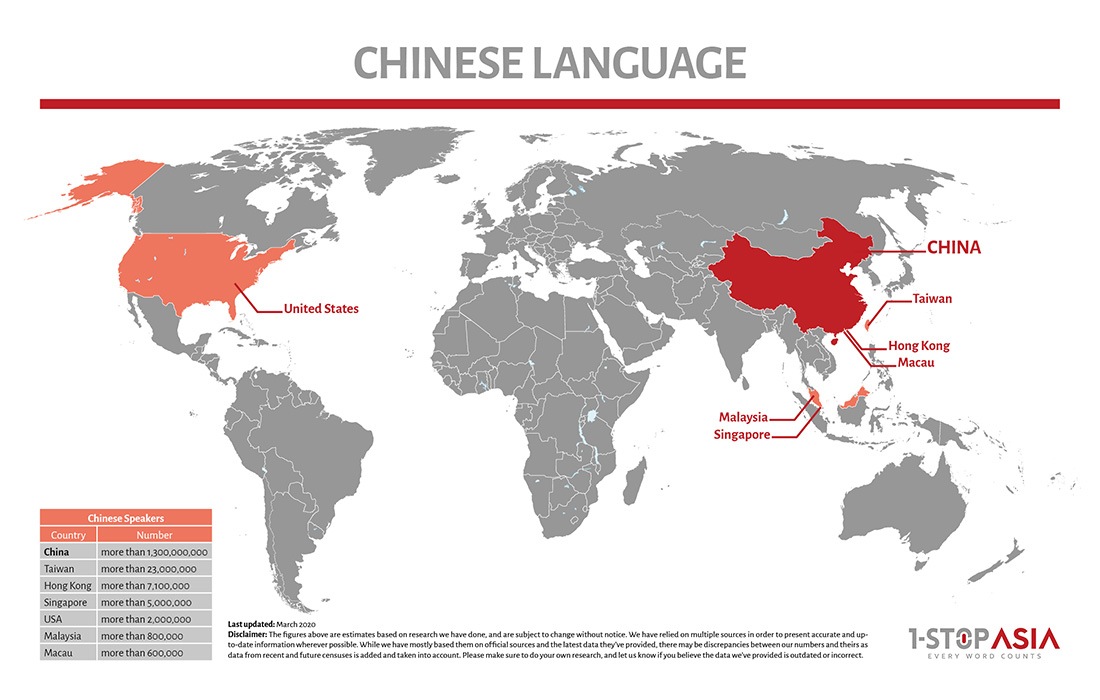Chinese Language
1.5B Chinese Speakers
The common usage of “Chinese” usually refers to Mandarin, but other well-known dialects in North America include Cantonese, Minnan (Taiwanese), and Hakka.
Chinese is by far the most widely spoken language in the world. In addition, it’s the fastest-growing language in the world, in both numbers of speakers and economic value. Over a billion people learn it as their first language. It is no wonder that Chinese translation is one of the most demanded services in the Asian languages segment.
As far as communication is concerned, people that speak it can understand each other without any problems if they’re using Mandarin (or dialects, such as Shanghainese and Taiwanese). But they can always detect different accents based on terms and phrases used, style of speaking, and handwriting quirks.
If you feel it is time to improve your time-management and pay more attention to your clients
The complexity of Chinese translation
1. The written language > Translation Service
- Writing system: There are two writing systems; Simplified Chinese — mainly used in mainland China, and Traditional Chinese — mainly used in Taiwan and Hong Kong.
- Character: The most obvious difference is the characters. Simplified Chinese, as its name indicates, has a simplified version of each character, so they’re easier to write and memorize. Traditional Chinese keep the original forms, which have developed over the course of a thousand years. Therefore, it’s easier for people who understand Traditional Chinese to pick up Simplified Chinese, but the opposite isn’t true.
- Honorifics: Chinese poses a considerable challenge for translation because of its abundant dialects, and the minor differences in the language used throughout the various territories it’s spoken in. As an example, there are two types of “you” — “您” (formal, honorific) and “你” (informal).
- Localization: Traditional Chinese is mainly used in Hong Kong and Taiwan, thus localization (especially the choice of words and expressions) is very important and dependent on your target market. Clients and/or native speakers from these two places will be able to tell the differences. There is another target audience that’s located in North America – the Chinese-speaking community. The older generation mostly immigrated from Hong Kong and Taiwan, while the newer generation immigrated from China. This is the reason why clients usually ask for both Simplified Chinese and Traditional Chinese translations when translating content that is to be used by Chinese speakers in North America.
2. The spoken language > Media Service
- Tone: All varieties of spoken Chinese use tones to distinguish words. A few dialects of North China may have as few as 3 tones, while some dialects in south China have up to 6 or 12 tones, depending on how one counts them. One exception from this is Shanghainese, which has reduced the set of tones to a two-toned pitch-accent system, not unlike modern Japanese. Different tones can drastically change a word’s meaning. Chinese is a tonal language, meaning that a word’s pitch can affect its meaning. For example, wǒ xiǎng wèn nǐ, in which “wen” is spoken with a falling pitch, means “I want to ask you”. But wǒ xiǎng wěn nǐ, in which “wen” rises and falls in pitch, means “I want to kiss you”.
Get exclusive insights into the world of translation, localization, and the language industry.
Our solution for you
Native translators with local knowledge
At 1-StopAsia, we help our clients identify their target market or audience and then fine-tune the language, writing system, style and tone of the exact type of Chinese they’re going to need. Our well-structured process ensures that your translation is translated and reviewed by a native Chinese translator with a specific subject-matter specialty, which helps us deliver a satisfactory final product.
25 years of experience
For over 2 decades in the industry, we’ve cultivated a team of Project Managers who have an in-depth understanding of the industry and most importantly, have access to a flexible project management system. They’re always there to handle your inquiries for Chinese translations, save your efforts and deliver the translation you need within the allotted time for each assignment.

